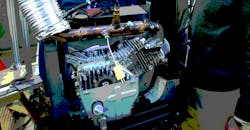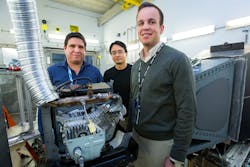Researchers Evaluate Aluminum Alloy Using Neutrons
In a first-of-its-kind experiment, researchers at Oak Ridge National Laboratory used neutrons to investigate the performance of components made of a new aluminum-cerium alloy on a gasoline-powered engine while it was running. They wanted to determine if the alloy would hold up under the heat and stress of an internal combustion engine.
The neutrons came from ORNL’s Spallation Neutron Source. Their unique properties let them penetrate materials and reveal fundamental details about the material’s atomic structure without harming or degrading it. The researchers also used Vulcan, a tool that uses neutrons to measure strain and stress on large industrial samples, which made it ideal for evaluating a cylinder head cast from an aluminum-cerium alloy. Cerium has been used as a strengthening agent for aluminum alloys.
The experiments confirmed that the new alloy outperforms other aluminum alloys at elevated temperatures.
“The automotive industry is currently interested in alloys that can hold up to high-heat demands of new, energy-efficient technologies. The aluminum-cerium alloy showed exceptional stability at temperatures above 500° C (932° F), which is unheard of for aluminum alloys. This means engines that use the alloy could run hotter, and components could be lighter, boosting efficiency and fuel economy,” says Orlando Rios, project leader and materials scientist at ORNL.
The Al-Ce cylinder head was cast using 3D-printed sand molds and retrofitted onto a prototype engine. Over the course of the three-day experiment, with the engine stopping and restarting via a remote ignition, neutron diffraction let researchers “see” the high-temperature stability of Al-Ce throughout the engine’s operating regime. Materials are exposed to complex forces and extreme temperatures during internal combustion, and researchers wanted to measure material performance during actual operating conditions.
This was a fundamental experiment not only to better understand this alloy, but also to provide some broader analysis that will let new alloys (not only aluminum compounds) be evaluated in this way, according to the research team. The experiment demonstrates the benefits of coupling fundamental science with early-stage research and developing new materials and technologies.


